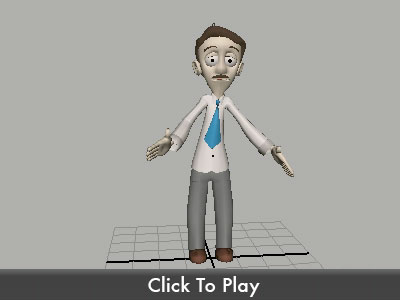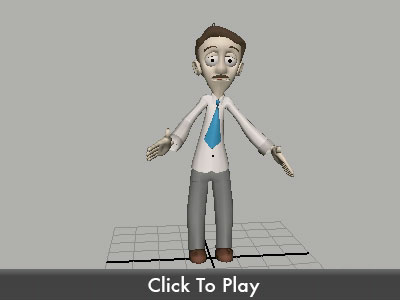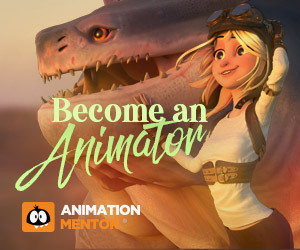Helpful Hints
A collection of tips and tricks to help you with your entries.
The Compliment Sandwich
By: Eric Scheur
Published April 23rd, 2009
When I decided I wanted to be an animator, I knew there were a lot of things I'd have to learn. I had no formal art training, so I had no choice but to start at the very beginning.I bought books that talked about timing and spacing, the twelve principles, the Nine Old Men, and how to use Maya. I overloaded my web browser's bookmarks with tutorials, interviews, demo reels, and blogs. I ordered DVDs from professional animators promising to share their techniques and secrets. With all of these educational materials before me, it was surely only a matter of time before I fully grasped all I needed to know about animation and my dream job would come a-calling.
Now that I have the first few years of an animation career under my belt, I can tell you that there is one aspect of animation that all of those books, blogs, and DVDs never prepared me for: Working with other animators.
As a social group, animators are an interesting species. Many animators grow up shy and reserved. Future animators tend to be nerds, geeks, and outcasts who are more comfortable in front of a computer screen than among a group of their peers. (I know I'm not talking about anyone reading this particular article, of course) This works out great for building the kind of patience and focus that animation requires. But it can also leave a huge deficit when it comes to developing the social skills needed for critiquing each others' work, which turns out to be just as big a part of being an animator as setting keyframes.
Critiques, like birthday gifts, can either be given or received. And like birthday gifts, the way they're packaged can contribute just as much to the enjoyment of the gift as the gift itself. It's so important to know how to offer a critique with tact and respect, yet so few of us take the time to wrap up our critiques with nice paper and a pretty bow. More often, we just dump them in the lap of our colleague with little more than a "Here. Take it or leave it."
There is also an acquired skill when it comes to accepting a critique with grace. The natural response to most critiques is to take it personally and deny that it can be valuable at all. We get defensive and stubborn. After all, no one knows as much about your animation as you do, right? How can anyone possibly hope to offer any insight without going against your original intentions for the shot?
Today we'll look at both sides of the critiquing coin, and examine some tips about how to be more gracious whether you're the giver or the receiver.
Ready? Let's dive in!
GIVING
The Compliment SandwichWe've all been there. Browsing through the Works In Progress forum, or rating each entry during the voting round. You come across an entry that looks like the animator has hardly put any effort into it at all.
It should be obvious that leaving a comment like "Wow. You suck." or "My eyes are bleeding after watching that!" is just plain mean-spirited.
I say it should be obvious, but the administrators of the 11 Second Club find dozens of comments every month that are that cruel, if not worse. Think back to the days when you knew nothing about animation, but you were inspired by Shrek or Aladdin or Toy Story, and you decided "I"m going to give this a shot!" Imagine working for hours and hours on your entry, trying to figure out this crazy software, shaking with rage when it doesn't seem to work the way you want it to, frustrated that your animation looks stiff, robotic, and unattractive. You may be even embarrassed to show your work, but you figure that the animation community can at least give you some pointers about what you can try next time. So you press the "submit" button.
Now imagine being told that instead of ever trying again, your fellow animators--the people you've looked up to and anticipated getting to know better--tell you that they regret even spending those 11 seconds watching the crap you made them sit through.
Yeah.
Alright, so maybe you read that last paragraph and said "Well, duh! That's what a jerk does. I'm not a jerk, and I would never leave such a cold and callous remark. At least I try to be helpful. For example, I might look at that last animation and say 'You're constantly moving around and not holding any poses. Also, your lipsync could use a lot of work.' See? That way they know what they need to work on for next time."
Offering constructive criticism is admirable, but it's also important to keep in mind how your criticism is being presented. Any critique is bound to feel like a judgement on an animator's skills. The animator remember all of the time and effort of each tiny decision and meticulous keyframe they've set, and you're about to tell them that they should have done something differently.
Fortunately there is a way to deliver this discouraging news that will make it seem less discouraging: The Compliment Sandwich.
Building a Compliment Sandwich is easy. Simply take your constructive criticism and surround it with two easily-digestable slices of appreciation, and serve. Remember what Mary Poppins said about a spoonful of sugar helping the medicine go down? Same principle.
There is always something good to find in anyone's animation, no matter what their skill level. Find that good thing and mention it first. Maybe it's a gesture they chose, or a particular facial expression. It might not even be related to the animation itself; perhaps you like the way their lighting sets the mood, or you think the gag they're trying to convey is very funny. If you can't find anything outright that you like about the piece, simply stating that you appreciate the animator's effort and courage at putting their work in front of dozens or hundreds of their peers can be a fine compliment to lead into a critique.
Your constructive criticism should follow next: that's the meat of the Compliment Sandwich. Make sure you're still respecting the animator's effort when you're offering your comments. Even if they didn't successfully convey their ideas, they were trying to. Use your best judgement to see what they were going for, and then base your critique on that. Acknowledge their work, and then suggest an improvement.
Finish up with one last dab of sweetness so the animator doesn't walk away with a bad taste in their mouth. Even if it's a quick reminder of something you already mentioned you enjoyed about their piece, it is enough to end on a positive note. Your message is delivered, and you've shown tact and respect to a fellow artist.
The Compliment Sandwich can be as large or as skinny as you please. Seven constructive comments will still be a lot easier to take with a veneer of ego-stroking on either side. Likewise, you don't have to spend forever constructing two gigantic paragraphs of praise just to escort a morsel of bad news. Your sandwich can be almost as quick to compose as the original critique; it just looks better when you present it.
| Your big gestures don't match the voice--make them smaller. Also, the lip-sync is way off... it kind of looks like the jaw is just flapping up and down. I also notice that your eyes drift around a lot. It's
distracting. Hey there. I like the thought you've put into your piece. I can definitely feel the character's remorse and sadness in some of the poses you've chosen. There are some areas, however, where the character is making big, broad gestures that don't seem to match the soft tone of the voice track. Also, I think you could concentrate more on the face--in particular the lip-sync doesn't seem quite nailed down, and the eyes drift all over the place instead of resting on one focal point at a time. Your work shows a lot of potential, and I look forward to seeing how this shot progresses. Good luck! |
RECEIVING
Here's a multiple choice question. The reason to ask for a critique is:If Answer D sounds ridiculous to you, congratulations; you are down with the idea that there is always something you can do to make your shot better. But you'd be surprised how often animators ask for a critique and then get super-defensive when the response is anything other than "Perfect!"
Okay, I'll admit it. In the back of my mind, I'm always hoping for that golden acknowledgment that my shot has the best possible animation and there are no improvements that could be made. I can't help it. I've worked hard on my shot, and I've labored over each and every pose, every single joint rotation, and all of the f-curves from the first to the last frame. I'd rather just hand my shot in to my director and say "Here! Done! Render it!"
Let's be honest, though: If I thought my shot was perfect, why would I have asked anyone for a critique in the first place? Right. I wouldn't have.
Now that I've admitted to myself that I need help with my shot, I should prepare myself for the critiques that will be coming my way. I need to accept that there are changes I will have to make, and that will mean tearing down a lot of the work I've put into my shot. But if I keep in mind that every one of these changes is in service of making my shot look better, it's easier to accept them as necessary and possibly even be enthusiastic about them.
Let's take another look at that animation from above, and examine 3 kinds of comments I might receive:
This is probably the most common type of critique. It is general but straightforward, and it speaks to a certain skill I need to put more energy into honing. It's true that I'm never really holding one pose in my animation, and I know that's something I need to work on. Even if I don't quite know how to do this technically, I can set a goal for myself: Learn how to hold my poses better. Whether this means that I need to learn more about splines in my graph editor, or setting fewer poses to begin with, or setting more keyframes, I'm able to move forward with a definite idea of where I need improvement.
This kind of critique also tends to be the kindest on the ego because it's something I probably already recognize in my own work. Having a pair of objective eyes confirm it helps me know that I'm headed in the right direction and that I will get there eventually if I keep trying.
My first reaction to this critique is "What are you talking about?? He's not clapping his hands at frame 54 or anywhere else! This comment is completely unhelpful."
Believe it or not, this comment may be the most helpful of the three. I simply need to dig in and find the useful information that this person is giving me. This requires some translation. Instead of reading the comment as:
it is much more useful if I read it this way:
Now we're arriving at the meat of this comment. The problem isn't that the commenter has imagined something that isn't in my shot, the problem is that my animation isn't reading clearly! And as a result of my animation not reading clearly, the commenter thought that my character was clapping his hands. And if one person sees hand-clapping, there are bound to be others who see it as well.
Sometimes we forget that our animation will ultimately end up in front of an audience that we have no personal contact with. We won't be there to explain what the character is actually doing in 3d space, or how we intended a gesture to be understood. We have to rely on our animation being as clear as possible so that anyone who watches it will understand why we animated it the way we did. With this in mind, we can give a final translation to the original critique that sounds like this:
"The silhouette of your characters' hands overlapping at frame 54 make it look like your character is clapping his hands. This probably isn't what you intended it to look like, and you may be able to get a better result by reworking the silhouette of that pose."
Instead of dismissing this comment as having misunderstood my animation, I am able to wring out some good advice by asking myself what prompted the comment at all.
Every once in a while I get a comment on my work that reminds me of some advice a co-worker once gave to me: "Take every critique with a grain of salt," he said. "It doesn't matter if it's John Lasseter himself giving you the critique, you have to decide whether it's appropriate to what you're animating. At the end of the day, this is your animation and no one else's."
One of the great things about getting critiques from other people is that other people are bound to have lots of different opinions. And one of the bad things about getting critiques from other people is that other people are bound to have lots of different opinions.
In this case, I don't feel like the commenter and I are on the same page about the mood of my shot. He wants it to have a gag, and I want it to be more of a serious dramatic performance. That's not to say that his opinion is wrong, but his comment just doesn't work for what I'm trying to achieve with my animation. I am deciding to respectfully ignore this comment and continue going in my own direction.
This is not a decision to make lightly, however. Most comments I have ever received on my animation were useful, and helped me improve my shot in ways that I would never have considered if I hadn't asked for help. It's rare to get advice that doesn't push me at least a little bit in the direction of making my shot better. Before you decide to ignore someone's critique, you must ask yourself if you're doing so because you are resisting changing a shot you've worked so hard on, or because you legitimately believe it won't help you. At least nine times out of ten, I've found that any critique I've received has made my shot better.
Good luck, and happy critiquing! :)
- Eric
Discuss this article in the comments section below, or in the 11 Second Club forums
comments powered by Disqus









